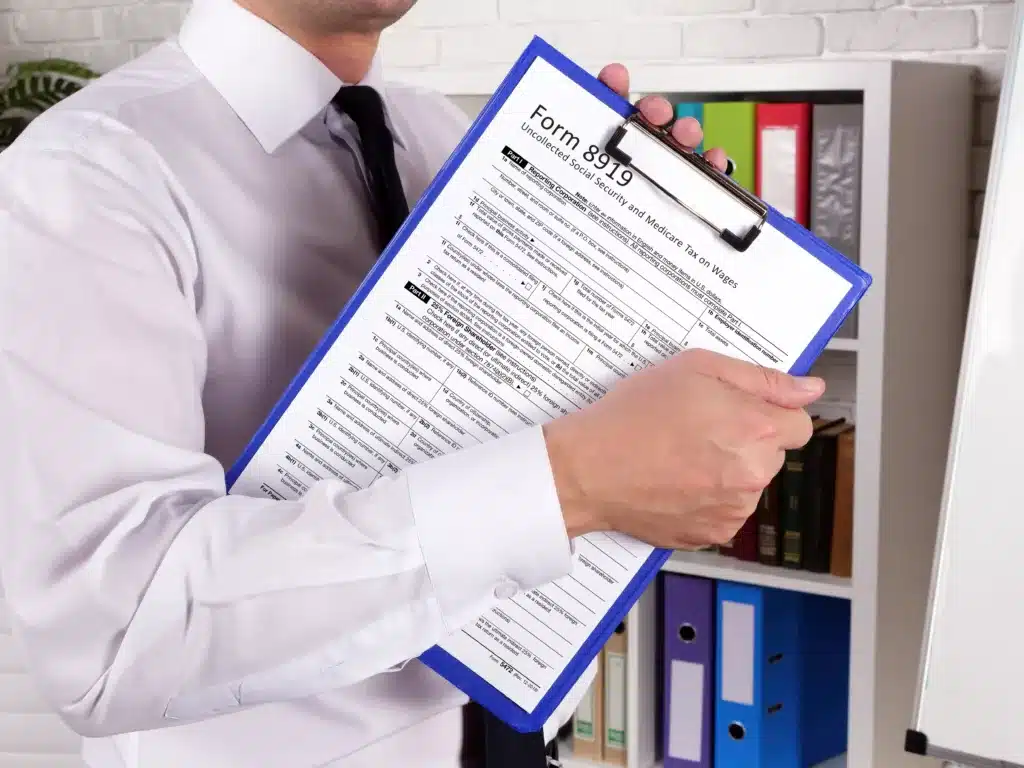IRS Form 8919 — How to Report Uncollected Taxes When You Are a Victim of Misclassification

What is Form 8919
The IRS Form 8919, or Uncollected Social Security and Medicare Tax on Wages, is an important document utilized by employed individuals who were wrongly classified as independent contractors by their employees. The form reports and calculates Medicare and Social Security taxes that the employer did not withhold from the employee’s paycheck.
In this article, we will guide you through filing Form 8919, including determining when to file and the steps to take when preparing the form.
Independent Contractor vs. Employee
Classifying workers as independent contractors or employees is a crucial distinction in the eyes of the IRS. The classification affects the amount of taxes that employers must withhold from workers’ paychecks and the amount of taxes that workers are responsible for paying.
The IRS uses a set of guidelines to determine whether a worker should be classified as an employee or an independent contractor. These guidelines focus on the degree of control an employer has over a worker’s job duties and how the worker is paid.
Independent contractors are individuals who are self-employed and work on a contract basis. They have more control over their work and how it is performed and typically provide their own tools and equipment. Employers generally do not withhold taxes from independent contractors’ paychecks. Instead, independent contractors are responsible for paying their own self-employment taxes.
On the other hand, employees work for an employer and are generally subject to more supervision and control. Employers must withhold Social Security and Medicare taxes from employees’ paychecks. They are also responsible for paying a portion of these taxes.
Worker Misclassification
Worker misclassification refers to the incorrect classification of workers as independent contractors rather than employees, intentionally or unintentionally. This misclassification can have significant implications and often results in back taxes for the employer and the employee. Some of these implications include the following:
For the employee:
- Inability to access specific employee benefits, such as health insurance, retirement plans, and workers’ compensation
- The responsibility to pay their self-employment taxes, which includes both the employer and employee portions of Social Security and Medicare taxes
- Ineligibility for overtime pay and other protections under the Fair Labor Standards Act
- Loss of legal protections afforded to employees, such as the right to file a discrimination or wrongful termination lawsuit
For the employer:
- Liability for unpaid taxes, including Social Security and Medicare taxes and unemployment insurance
- Fines and penalties from the IRS and state agencies for failure to correctly classify employees
- Potential for lawsuits and legal action from misclassified employees seeking back pay, benefits, and other compensation
- Damage to the employer’s reputation and relationships with employees and customers
Form SS-8
If you feel like your employer has incorrectly categorized you as an independent contractor, there is a way to challenge your determination. To contest your status, you can use IRS Form SS-8. This will help the IRS determine whether you should be classified as an employee or an independent contractor. Once the IRS has all the necessary information, they will issue a determination you can rely on when filing your taxes.
When to File Form 8919
After you submit Form SS-8 to the IRS to determine your employment status, you can go ahead and file Form 8919 to properly report your share of Social Security and Medicare taxes. By filing Form 8919, you can save 7.65% of employment taxes your employer should have covered. Additionally, this ensures that your Social Security earnings will be accurately credited to your Social Security record.
It’s worth noting that you don’t need to wait for the IRS to determine your employment status before filing Form 8919. You can file the form alongside your tax return, even if the IRS has not yet made a determination.
How to Prepare Form 8919
- Start by filling in your name and Social Security number on the top section of the form.
- Complete a separate line on Form 8919 for each employer you’ve worked for on lines 1 through 5. If you had more than 5 employers, attach another Form 8919.
- In line 6, add the amounts listed in column (f) to calculate your total wages.
If you are filing Form 8959, you must also enter the total from line 6 of Form 8919 on line 3 of Form 8959.
- The Social Security tax maximum of $142,800 has been pre-entered for you on line 7.
- Input your total Social Security wages and tips, unreported tips, and railroad retirement compensation on line 8. However, when reporting railroad retirement (RRTA) compensation, do not include an amount greater than $ 147,000; this is the limit subject to the 6.2% rate for 2022.
- Follow the mathematical instructions for lines 11 through 13 and enter the resulting value.
Get Help Filing Form 8919
Filing Form 8919 is crucial for individuals wrongly classified as independent contractors by their employers. By correctly reporting your Social Security and Medicare taxes, you can save money and ensure that your Social Security earnings will be credited to your record.
Mistakes in filing Form 8919 can result in penalties and fines. Therefore, we highly encourage you to seek help from a qualified tax professional to ensure correct filing and avoid potential consequences. Contact Tax Samaritan for assistance with Form 8919 and other tax-related matters.
